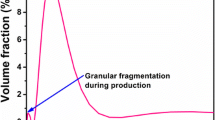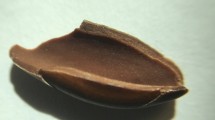Abstract
The thermal degradation behavior of the biocomposite with thermoplastic starch (TPS), poly(ε-caprolactone) (PCL) and bleached sisal fibers were investigated by thermogravimetry analysis (TG/DTG) under synthetic air atmosphere, differential scanning calorimetry, and their crystal structure by X-ray diffraction. Applying the non-isothermal Ozawa method, the TG/DTG curves average activation energy could be obtained for thermal degradation of the biocomposites with 5, 10, and 20 % of bleached sisal fibers. The apparent activation energy values for the biocomposites decreased when compared with the TPS/PCL blend, requiring lower energy to recycle this material. However, continuous addition of sisal fibers increased the activation energy of composites.






Similar content being viewed by others
References
Cyras VP, Martucci JF, Iannace S, Vazquez A. Influence of the fiber content and the processing conditions on the flexural creep behavior of sisal–PCL–starch composites. J Thermoplast Compos. 2000;15:253–65.
Whisler RL, Memiller JN, Paschall EF. Starch chemistry and technology. New York: Academic Press; 1984.
Peanasky JS, Long JM, Wool RP. Percolation effects in degradable polyethylene–starch blends. J Polym Sci. 1991;29:565–79.
George ER, Sullivan TM, Park EH. Thermoplastic starch blends with a poly(ethylene-co-vinyl alcohol): processability and physical properties. Polym Eng Sci. 1994;34:17–23.
Swanson CL, Shogren RL, Fanta GF, Iman SH. Starch–plastic materials—preparation, physical properties, and biodegradability (a review of recent USDA research). J Environ Polym Degrad. 1993;1:155–66.
Raghavan D, Emekalan A. Characterization of starch/polyethylene and starch/polyethylene/poly(lactic acid) composites. Polym Degrad Stab. 2001;72:509–17.
Griffith LG. Polymeric biomaterials. Acta Mater. 2000;48:263–77.
Chandra R, Rustgi R. Biodegradable polymers. Prog Polym Sci. 1998;23:1273–335.
Darwis D, Mitomo H, Enjoji T, Yoshii F, Makuuchi K. Enzymatic degradation of radiation crosslinked poly(3-caprolactone). Polym Degrad Stab. 1998;62:259–65.
Yu L, Dean K, Li L. Polymer blends and composites from renewable resources. Prog Polym Sci. 2006;31:576–602.
Bledzki AK, Gassan J. Composites reinforced with cellulose based fibres. Prog Polym Sci. 1999;24:221–74.
Mohanty AK, Misra M, Hinrichsen G. Biofibres, biodegradable polymers and biocomposites: an overview. Macromol Mater Eng. 2000;276(277):1–24.
Nishino T, Hirao K, Kotera M, Nakamae K, Inagaki H. Kenaf reinforced biodegradable composite. Compos Sci Technol. 2003;63:1281–6.
Wong S, Shanks R, Hodzic A. Properties of poly (3-hydroxybutyric acid) composites with flax fibers modified by plasticiser absorption. Macromol Mater Eng. 2002;287:647–55.
Alvarez V, Vázquez A. Thermal degradation of cellulose derivatives/starch blends and sisal fibre biocomposites. Polym Degrad Stab. 2004;84:13–21.
Campos A, Teixeira EM, Marconcini JM, Chiou B-S, Orts WJ, Wood D, Mattoso LHC, Imam SH. Starch/polycaprolactone-containing composites reinforced with pre-treated sisal fibers. Trends Polym Sci. 2011;15:89–99.
Sivalingam G, Karthik R, Madras G. Kinetics of thermal degradation of poly (ε-caprolactone). J Anal Appl Pyrolysis. 2003;70:631–47.
Yao F, Wu Q, Lei Y, Guo W, Xu Y. Thermal decomposition kinetics of natural fibers: activation energy with dynamic thermogravimetric analysis. Polym Degrad Stab. 2008;93:90–8.
Sathasivam K, Haris MRHM. Thermal properties of modified banana trunk fibers. J Therm Anal Calorim. 2012;108:9–17.
Sun JX, Sun XF, Zhao H, Sun RC. Isolation and characterization of cellulose from sugarcane bagasse. Polym Degrad Stab. 2004;84(2):331–9.
Ozawa T. A new method of analyzing thermogravimetric data. Bull Chem Soc.;65(38):1881–6.
Carmona VB, Oliveira RM, Silva WTL, Mattoso LHC, Marconcini JM. Nanosilica from rice husk: extraction and characterization. Ind Crop Prod. 2013;43:291–6.
Vertuccio L, Gorrasi G, Sorrentino A, Vittoria V. Nano clay reinforced PCL/starch blends obtained by high energy ball milling. Carbohydr Polym. 2009;75:172–9.
Kesel CD, Lefevre C, Nagry JB, David C. Blends of polycaprolactone with polyvinylalcohol: a DSC, optical microscopy and solid state NMR study. Polymer. 1999;40:1969–78.
Borysiak S, Garbaczyk J. Applying the WAXS method to estimate the supermolecular structure of cellulose fibres after mercerisation. Fibres Text East Eur. 2003;11:104–7.
Hulleman SHD, Kalisvaart MG, Jansen FHP, Feil H, Vliegenthart JFG. Origins of B-type crystallinity in glycerol-plasticised, compression-molded potato starches. Carbohyd Polym. 1999;39:351–60.
Tomczak F, Satyanarayana KG, Sydenstricker THD. Studies on lignocellulosic fibers of Brazil: part III—morphology and properties of Brazilian curaua fibers. Compos Part A. 2007;38:2227–36.
Guinesi LS, da Róz AL, Corradini E, Teixeira EM, Curvelo AAS. Kinetics of thermal degradation applied to starches from different botanical origins by non-isothermal procedures. Thermochim Acta. 2006;447:190–6.
Draye A, Persenaire O, Brozek O, Roda J, Kosek T, Dubois Ph. Thermogravimetric analysis of poly(ε-caprolactam) and poly[(ε-caprolactam)-co-(ε-caprolactone)] polymers. Polymer. 2001;42:8325–32.
Aoyagi Y, Yamashita K, Doi Y. Thermal degradation of poly[(R)-3-hydroxybutyrate], poly[ε-caprolactone], and poly[(S)-lactide]. Polym Degrad Stab. 2002;76:53–9.
Di Franco CR, Cyras VP, Busalmen JP, Ruseckaite RA, Vásquez A. Degradation of polycaprolactone/starch blends and composites with sisal fibre. Polym Degrad Stab. 2004;86:95–103.
Yang H, Yan R, Chen H, Lee DH. Zheng C. Characteristics of hemicellulose, cellulose and lignin pyrolysis fuel. 2007;86:1781–8.
Martin AR, Alice M, Odilon RRF, Mattoso LHC. Studies on the thermal properties of sisal fiber and its constituents. Thermochim Acta. 2010;506:14–9.
Ruseckaite R, Jiménez A. Thermal degradation of mixtures of polycaprolactone with cellulose derivatives. Polym Degrad Stab. 2003;81:353–8.
Avérous L, Le Digabel F. Properties of biocomposites based on lignocellulosic fillers. Carbohyd Polym. 2006;66:480–93.
Shuttleworth PS, Budarin V, Clark JH. Thermal investigation of “molten starch”. J Therm Anal Calorim. 2011;105:577–81.
Mansaray KG, Ghaly AE. Determination of kinetic parameters of rice husks in oxygen using thermogravimetric analysis. Biomass Bioenerg. 1999;17:19–31.
Sonobe T, Worasuwannarak N. Kinetic analyses of biomass pyrolysis using the distributed activation energy model. Fuel. 2008;87:414–21.
Borysiak S. Supermolecular structure of wood/polypropylene composites: I. The influence of processing parameters and chemical treatment of the filler. Polym Bull. 2009;64:275–90.
He Y, Inoue Y. Novel FTIR method for determining the crystallinity of poly (3-caprolactone). Polym Int. 2000;49:623–6.
Siqueira G, Bras J, Dufresne A. Cellulose whiskers versus microfibrils: influence of the nature of the nanoparticle and its surface functionalization on the thermal and mechanical properties of nanocomposites. Biomacromolecules 2009;10:425–32.
Borysiak S. Influence of wood mercerization on the crystallization of polypropylene in wood/PP composites. J Therm Anal Calorim. 2012;109:595–603.
Di Y, Iannace S, Maio ED, Nicolais L. Nanocomposites by melt intercalation based on polycaprolactone and organoclay. J Polym Sci. 2003;41:670–8.
Chen E, Wu T. Isothermal crystallization kinetics and thermal behavior of poly(3-caprolactone)/multi-walled carbon nanotube composites. Polym Degrad Stab. 2007;92:1009–15.
Ahmed J, Auras R, Kijchavengkul T, Varshney SK. Rheological, thermal and structural behavior of poly(ε-caprolactone) and nanoclay blended films. J Food Eng. 2012;111:580–9.
Campos A, Tonoli GHD, Marconcini JM, Mattoso LHC, Klamczynski A, Gregorski KS, Wood D, Williams T, Chiou B-S, Imam SH. TPS/PCL composite reinforced with treated sisal fibers: property, biodegradation and water-absorption. J Polym Environ. 2012; doi:10.1007/s10924-012-0512-8.
Cheng HKF, Sahoo NG, Lu X, Li L. Thermal kinetics of montmorillonite nanoclay/maleic anhydride-modified polypropylene nanocomposites. J Therm Anal Calorim. 2012;109:17–25.
Shanks RA, Gunaratne LMWK. Gelatinization and retrogradation of thermoplastic starch characterized using modulated temperature differential scanning calorimetry. J Therm Anal Calorim. 2011;106:93–9.
Magalhaes NF, Andrade CT. Thermoplastic corn starch/clay hybrids: effect of clay type and content on physical properties. Carbohydr Polym. 2009;75:712–8.
Xing Z, Yang G. Crystallization, melting behavior, and wettability of poly(ε-caprolactone) and poly(ε-caprolactone)/poly(N-vinylpyrrolidone) blends. J Appl Polym Sci. 2010;115:2747–55.
Acknowledgments
The authors are grateful for the financial support of the projects granted by FAPESP (2008/08264-9), Capes, CNPq, FINEP, and Embrapa.
Author information
Authors and Affiliations
Corresponding author
Rights and permissions
About this article
Cite this article
Carmona, V.B., de Campos, A., Marconcini, J.M. et al. Kinetics of thermal degradation applied to biocomposites with TPS, PCL and sisal fibers by non-isothermal procedures. J Therm Anal Calorim 115, 153–160 (2014). https://doi.org/10.1007/s10973-013-3259-0
Received:
Accepted:
Published:
Issue Date:
DOI: https://doi.org/10.1007/s10973-013-3259-0




